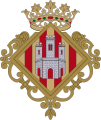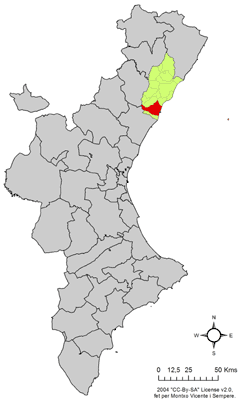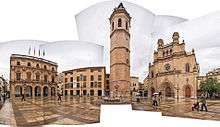Castellón de la Plana
Castellón de la Plana (Spanish pronunciation: [kasteˈʎon de la ˈplana]), Castelló de la Plana (official) (Valencian pronunciation: [kasteˈʎo ðe la ˈplana]), or simply Castellón, is the capital city of the province of Castellón, in the Valencian Community (Spain). It is located in the east of the Iberian Peninsula, on the Costa del Azahar by the Mediterranean Sea. The mountain range known as Desert de les Palmes rises inland north of the town.
Castellón de la Plana Castelló de la Plana (Valencian) | |
|---|---|
| Castelló de la Plana[1] | |
 Central parts of Castelló de la Plana. | |
 Flag  Coat of arms | |
 Location in the Valencian Community | |
 Castellón de la Plana Location in Spain | |
| Coordinates: 39°58′59″N 0°1′59″W | |
| Country | |
| Autonomous community | |
| Province | Castellón |
| Comarca | Plana Alta |
| Judicial district | Castelló de la Plana |
| Government | |
| • Alcaldesa | Amparo Marco Gual (2015) (PSPV-PSOE) |
| Area | |
| • Total | 108.78 km2 (42.00 sq mi) |
| Elevation | 30 m (100 ft) |
| Highest elevation | 609 m (1,998 ft) |
| Lowest elevation | 0 m (0 ft) |
| Population (2018)[2] | |
| • Total | 170,888 |
| • Density | 1,600/km2 (4,100/sq mi) |
| Demonyms | Castellonenc, Castellonenses |
| Time zone | UTC+1 (CET) |
| • Summer (DST) | UTC+2 (CEST) |
| Postal code | 12001-06 |
| Dialing code | 964 |
| Official language(s) | Valencian, Spanish |
| Climate | BSk |
| Website | Official website |

According to the 2018 census, Castellón has a population of 170,888 inhabitants (called castellonencs in Valencian), ranking as the fourth most populated city in the Valencian Community (after Valencia, Alicante and Elche). The Prime Meridian or Greenwich Meridian, crosses Castelló de la Plana, and intersects with the 40th Parallel, and commemorates it with a monolith in Meridian Park (Parque del Meridiano) located at the exact point where this occurs.
History
The first known building in the area was the Moorish castle of Fadrell, near the Alqueries de La Plana. The town proper was officially founded in 1251, after the conquest of the Moorish Kingdom of Valencia by King James I of Aragon in 1233. James granted royal permission to move the town from the mountain to the plain on 8 September 1251, and tradition claims that the move was completed by the third Sunday of Lent, 1252. During the Middle Ages, the city was protected by moats, walls and towers, and a church was built, later becoming a cathedral. In the 16th century the town was one of the last strongholds in the Revolta de les Germanies (local guilds). It also supported Archduke Charles of Austria in the War of the Spanish Succession (1701–14), but was later taken by the troops of Philip d'Anjou.
In the 19th century, the city walls were torn down and it slowly began to expand, a process interrupted by the War of Independence against Napoleon (1804–14) and the Carlist Wars (1833–63). In 1833 Castelló became the capital of the newly constituted province. In the second half of the 19th century, the city again began to expand, marked by the arrival of the railway, the enlargement of the port and the construction of representative buildings (Provincial Hospital, Casino, Theater) and parks.
In 1991 a university (Jaume I University) was established, set upon a modern campus. The local economy is based on industry, tourism and craft-work.
Main sights
Most of the historical buildings are located in the diminutive old town, around the Plaça Major (Main Square). These include:
- The Concatedral de Santa Maria (co-cathedral of Saint Mary), built in a Gothic-style in the 13th century and reconstructed one century later after destruction by fire. The present building is another reconstruction after the demolition ordered by the council during the Spanish civil war (1936).[3]
- The Ajuntament (City Hall), erected at the beginning of the 18th century. It features a Tuscan-style façade rising up over a colonnade.
- The free-standing bell-tower of the procathedral, known as El Fadrí (the single man), built in the 15th century.Planetari de Castelló
- The Llotja del Cànem (Hemp Exchange Market), built during the first half of the 17th century to be used by traders in hempen cloth and ropes, a very important activity in the area at the time. Today the building is used by the University for cultural events and temporary exhibitions.
- On the northeast edge of the town, at the end of a broad avenue decorated with orange trees, stands the Basílica of Santa Maria del Lledó (European Hackberry or Celtis australis), a basilica devoted to an image of the Virgin Mary found in 1366 by a farmer when he was ploughing his lands. The original 14th-century chapel was extended to its present Baroque form during the 16th century.
- Espai d'Art Contemporani de Castelló, Museum for Modern Art
- Teatre Principal
Events
The annual festivities in Castellón are a week of celebrations three weeks before Easter every year called La Magdalena. People come from all over the province and many international bands and groups participate.
The city is notorious for its music festivals, among which we find: early in February the Tanned Tin music festival for alternative music and experimental music, in July the Festival Internacional de Benicàssim (also known as FIB, which translates to Benicàssim's International Festival), at the beginning of August there is the Arenal Sound and during the middle of that same month, we can find the Rototom Sunsplash Festival, known for its reggae music.
Sports
The city has the professional basketball team AB Castelló, which plays in LEB Oro, Spanish second basketball division.
The local professional football club is CD Castellón. However, despite having a 15,000 seater stadium (Nou Estadi Castàlia), the club financial problems and unstable history brought it to play in semi-pro and amateur regional divisions, not playing in La Liga since the 1990–91 season. On 21 March 2018, Castellón beat the record of seasonal tickets in the fourth-tier division with 12,701, and is considered a giant amongst minnows.[4] Currently they play on Spain's third league. The presence of Villarreal CF in the adjacent town (only 8 km away) has created a fierce rivalry for geographical reasons. The success of Villarreal in the last decades, with a stable presence in La Liga since 2000 and including several European qualifications, is turning more and more supporters to its side.
The city is host to futsal club CFS Bisontes Castellón, which under the name Playas de Castellón was one of the best Spanish and European futsal clubs in the late 90s and early 2000s, having won the premier professional futsal league in Spain twice in 2000 and 2001, and the UEFA Futsal Cup three consecutive times in 2001, 2002 and 2003.
Education
Jaume I University was founded in 1991, and in 2014 there were approximately 15,000 students enrolled who share a single campus.
Twin towns




Notable people
- Sergio Aragonés (born 1937), comics cartoonist.
- Joan Barreda Bort (born 1983), Rally raid motorcyclist.
- Roberto Bautista-Agut (born 1988), professional tennis player.
- José Luis Ballester (born 1969), Olympic butterfly swimmer.
- María Egual (1655–1735), poet and dramatist.
- Sergio García (born 1980), professional golfer.
- Pablo Hernandez Dominguez (born 1985), footballer, formerly with Valencia CF.
- Roberto Merhi, (born 1991), driver.
- Matilde Salvador (born 1918, died 2007), musician, composer and painter artist.
- Miguel Angel Silvestre, (born 1982), actor.
- Xavi Valero (born 1973), professional football goalkeeping coach.
Climate
The Köppen Climate Classification subtype for this climate is "BSk" (Tropical and Subtropical Steppe Climate).[5]
| Climate data for Castellón de la Plana, Almazora 43m (1981–2010), extremes (1940–) | |||||||||||||
|---|---|---|---|---|---|---|---|---|---|---|---|---|---|
| Month | Jan | Feb | Mar | Apr | May | Jun | Jul | Aug | Sep | Oct | Nov | Dec | Year |
| Record high °C (°F) | 27.4 (81.3) |
28.8 (83.8) |
30.2 (86.4) |
30.6 (87.1) |
35.0 (95.0) |
37.4 (99.3) |
40.6 (105.1) |
39.4 (102.9) |
36.0 (96.8) |
33.4 (92.1) |
29.0 (84.2) |
25.4 (77.7) |
40.6 (105.1) |
| Average high °C (°F) | 15.3 (59.5) |
16.2 (61.2) |
18.5 (65.3) |
20.5 (68.9) |
23.4 (74.1) |
27.3 (81.1) |
30.0 (86.0) |
30.3 (86.5) |
27.6 (81.7) |
23.5 (74.3) |
18.8 (65.8) |
15.8 (60.4) |
22.3 (72.1) |
| Daily mean °C (°F) | 10.6 (51.1) |
11.3 (52.3) |
13.4 (56.1) |
15.4 (59.7) |
18.5 (65.3) |
22.5 (72.5) |
25.3 (77.5) |
25.6 (78.1) |
22.9 (73.2) |
19.0 (66.2) |
14.3 (57.7) |
11.4 (52.5) |
17.5 (63.5) |
| Average low °C (°F) | 5.8 (42.4) |
6.4 (43.5) |
8.3 (46.9) |
10.3 (50.5) |
13.6 (56.5) |
17.6 (63.7) |
20.6 (69.1) |
20.9 (69.6) |
18.1 (64.6) |
14.4 (57.9) |
9.8 (49.6) |
7.0 (44.6) |
12.7 (54.9) |
| Record low °C (°F) | −4.4 (24.1) |
−2.2 (28.0) |
0.4 (32.7) |
2.8 (37.0) |
5.2 (41.4) |
10.2 (50.4) |
12.0 (53.6) |
12.2 (54.0) |
9.8 (49.6) |
5.4 (41.7) |
−1.8 (28.8) |
−0.6 (30.9) |
−4.4 (24.1) |
| Average precipitation mm (inches) | 36 (1.4) |
31 (1.2) |
31 (1.2) |
42 (1.7) |
44 (1.7) |
19 (0.7) |
9 (0.4) |
24 (0.9) |
71 (2.8) |
70 (2.8) |
49 (1.9) |
42 (1.7) |
467 (18.4) |
| Average precipitation days (≥ 1 mm) | 4 | 4 | 3 | 5 | 5 | 3 | 1 | 2 | 5 | 5 | 4 | 4 | 46 |
| Average relative humidity (%) | 67 | 66 | 64 | 63 | 63 | 63 | 64 | 66 | 68 | 69 | 68 | 68 | 66 |
| Mean monthly sunshine hours | 180 | 179 | 209 | 235 | 272 | 296 | 329 | 290 | 229 | 203 | 173 | 164 | 2,755 |
| Source: Agencia Estatal de Meteorología[6] | |||||||||||||
Transport
The small Castellón Airport offers charter and general aviation services, as well as scheduled passenger services to London, Bucharest and Poznań. The new Castellón-Costa Azahar Airport is designed to support large international jet flights and was completed in 2011. It has become a symbol of the wasteful spending prior to the 2008–13 Spanish financial crisis. Valencia Airport is about 70 km (43 mi) south whilst Alicante Airport is another 185 km (115 mi) further down the coast.
The city is served by the Castellón de la Plana railway station. The Euromed railway line links Alicante to Barcelona.
Nowadays, this city has a new public transport called TRAM de Castellón which is a trolleybus. There is just a line Línea 1 (TRAM de Castellón), but authorities are planning to build the second line.
See also
- Diocese of Segorbe-Castellón.
- Columbretes Islands
References
- Decret 40/2019, de 22 de març, del Consell, d'aprovació del canvi de denominació del municipi de Castelló de la Plana/Castellón de la Plana per la forma exclusiva en valencià Castelló de la Plana Generalitat Valenciana
- Municipal Register of Spain 2018. National Statistics Institute.
- .Obras religiosas destruidas durante la guerra civil (spanish)
- "El CD Castellón hace historia al superar el récord de abonados en Tercera División" (in Spanish). 21 March 2018. Retrieved 21 March 2018.
- "Climate Summary for Castellón de la Plana". weatherbase.com. Retrieved 19 November 2015.
- "Valores climatológicos normales. Castellón de la Plana, Almazora".
External links
| Wikivoyage has a travel guide for Castellón. |